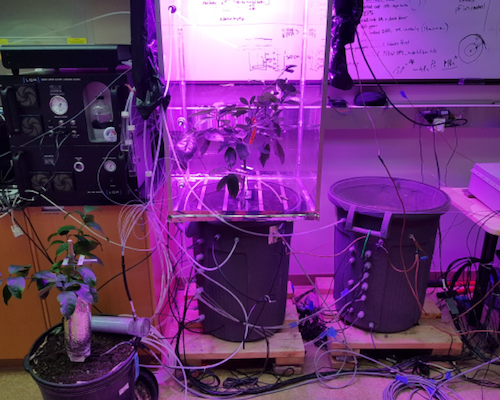
Isotope Behaviour in the Root-Soil Interface
Examining the "Two Water Worlds Hypothesis"
The Experiment
Masters of Water Security candidate, John Guselle; PhD candidate, Magali Nehemy; and Postdoc, Marcel Gaj have initiated an experiment that will explore the "Two Water Worlds Hypothesis" and ask if tension based fractionation processes at the root-soil interface are present in vegetated soils. The experiment will test whether isotope fractionation in soils is solely caused by diffusional processes or if vapour pressure gradients driven in part by plant root activity could also be causing fractionation at the soil-water-vapour interface?
The laboratory set up consists of two soil buckets which are sealed in plexiglass enclosures and mounted on load cells. One bucket has an orange tree planted in it and the second (control) is just bare soil. The orange tree is also enclosed in plexiglass and isolated from the soil below.
This experimental setup is unique, in that the design allows complete control of the isotopic composition of all the water and water vapour inputs into the experimental enclosures and the isotopic composition of any outputs are measured in real-time using an on-line laser spectrometer. The soils are monitored for tension, moisture and temperature and the team can monitor what the tree is up to by measuring sap flux and changes in stem diameter. The team anticipates that this level of monitoring and control will provide new insight into fractionation mechanisms at the root-soil interface
This work will contribute to the isotope-based partitioning of transpiration and evaporation, which relies on predictable plant and soil fractionation mechanisms to trace water sources. A better understanding of the fractionation mechanisms at the root-soil interface could ultimately lead to improved estimates of evapotranspiration for hydrology and climate change modeling.
Supplemental Information
Lab Note: By John Guselle
LemonAid - Save the Juice
What happens if a former electrician, a former mining engineer, and a Brazilian forestry engineer get together in an isotope laboratory at the beginning of a Saskatoon winter? Of course, we build something while dreaming of tropical temperatures and green leaves.
The team needs a lemon tree.
It's -20oC outside and we buy a lemon tree and bring it back to the lab. Elated by the presence of green leaves and the prospect of initiating ground-breaking research, we move to phase two of the experiment. But not so fast. The lemon tree, having been momentarily exposed to cold air during transport to the lab, loses all its leaves and appears dead. Naturally, the team jumps into action to save the tree. We administer, you guessed it, lemon aid. The lab becomes a critical care unit but despite the teams' best efforts to save the tree—we give it water and light—the lemon tree remains in a lifeless state.
The team needs an orange tree.
We buy an orange tree and bring it back to the lab. Desperate to avoid losing a second tree we use our newly built experimental setup to put the tree on full life support. This time, the team takes no chances; we water the tree and give it light. We also install instrumentation to monitor virtually every aspect of the orange tree at high temporal resolution. The tree thrives.
By the way, the lemon tree is alive and well (see the small tree in the left bottom corner of the photo above); our team retains its perfect treatment record!
The Team
Former mining engineer is John Guselle, Brazilian forest engineer is Magali Nehemy, and the former electrician is Marcel Gaj.
